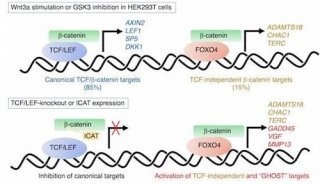Presenilin action in Notch and Wnt signaling

Presenilin-1 (PS1) is associated with gamma secretase activity that cleaves amyloid precursor protein (APP) and is implicated in Alzheimer's disease. Presenilin-1 is also a component in gamma-secretase activity involved in signaling by the transmembrane protein Notch. Active gamma secretase requires PS-1 N-terminal fragment and a C-terminal fragment and is unique in catalyzing proteolysis within the transmembrane region of proteins. Other proteins such as nicastrin may also be components of the gamma-secretase. Binding of the ligand Delta by Notch appears to trigger two proteolytic cleavages of Notch. The first step cleaves an extracellular domain and is catalyzed by a metalloprotease termed alpha-secretase or TACE. The second cleavage step appears to occur within the transmembrane domain of Notch, and releases a Notch intracellular doman (NICD). Once released, NICD moves into the nucleus where it is involved in transcriptional regulation through CSL family transcription factors (CBF1, Su(H), Lag-1) or other transcriptional regulators such as LEF-1. Presenilin is also involved in the Wnt/frizzled signaling pathway (see WNT signaling pathway) through beta-catenin. Beta-catenin is a cytoskeletal component that enters the nucleus to act as a transcriptional cofactor. Binding of WNT to Frizzled causes disheveled (DSH) to inhibit Glycogen synthase kinase 3 beta (GSK-3b) activity. Phosphorylation of Beta-catenin induces the ubiquitination and proteolytic degradation of beta-catenin by the proteasome. Non-phosphorylated beta-catenin is stable and enters the nucleus to regulate transcription with TCF. The beta-catenin/TCF complex activates genes that promote cellular survival, proliferation and differentiation during development. Presenilin stimulates beta-catenin turnover, reducing its transcriptional activation.
Contributor:
REFERENCES: De Strooper, B., Annaert W. Where Notch and Wnt Signaling Meet: The Presenilin Hub. J. Cell Biol. 2001, 152(4):pp F17-F19 De Strooper, B., et al. A presenilin-1-dependent gamma-secretase-like protease mediates release of Notch intracellular domain. Nature 1999, 398(6727):518-22 Nishimura, M., et al. Presenilin mutations associated with Alzheimer disease cause defective intracellular trafficking of beta-catenin, a component of the presenilin protein complex. Nat. Med. 1999, 5(2):164-9 Schroeter, E.H., Kisslinger, J.A., Kopan, R. Notch-1 signaling requires ligand-induced proteolytic release of intracellular domain. Nature 1998, 393(6683):382-6 Song, W., et al. Proteolytic release and nuclear translocation of Notch-1 are induced by presenilin-1 and impaired by pathogenic presenilin-1 mutations. Proc. Natl. Acad. Sci. U. S.A. 1999, 96(12):6959-63 Soriano, S., et al. Presenilin 1 negatively regulates beta-catenin/T cell factor/lymphoid enhancer factor-1 signaling independently of beta-amyloid precursor protein and notch processing. J. Cell Biol. 2001, 152(4):785-94 Xia, X., et al. Loss of presenilin 1 is associated with enhanced beta-catenin signaling and skin tumorigenesis. Proc Natl Acad Sci U S A 2001, 98(19):10863-8
-
科技前沿









